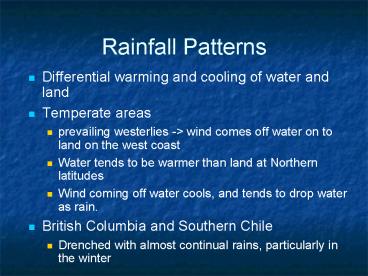Rainfall Patterns - PowerPoint PPT Presentation
1 / 24
Title:
Rainfall Patterns
Description:
Water tends to be warmer than land at Northern latitudes ... Buffalo, New York shattered its all-time 24-hour snowfall record when 38 in. ... – PowerPoint PPT presentation
Number of Views:3297
Avg rating:3.0/5.0
Title: Rainfall Patterns
1
Rainfall Patterns
- Differential warming and cooling of water and
land - Temperate areas
- prevailing westerlies -gt wind comes off water on
to land on the west coast - Water tends to be warmer than land at Northern
latitudes - Wind coming off water cools, and tends to drop
water as rain. - British Columbia and Southern Chile
- Drenched with almost continual rains,
particularly in the winter
2
U.S. West Coast
- Oregon and Northern California
- Land is a bit warmer than the water in the
summer. - In the winter the land is cooler than the water,
- Southern California
- Land is almost always warmer than the ocean.
Little rain results except in the high mountains. - The westerlies here are thirsty
3
Baja
- Not only is the land quite warm, the water is
much colder - Strong local winds pulling water away from the
coast. - Coriolis force
- Upwelling
- Water coming from the deep is both cold and
nutrient rich. - These factors, plus the latitude make Baja a very
dry place
4
Atacama desert
- Found in Northern Chile
- The land is much warmer than the water
- Found at 25º So. latitude.
0º
25º
5
Air movement above 30º
- Surface air moves poleward from 30º to about 60º.
- Air moves from the pole toward 60º also
- the cell rises somewhere between 50º and 60º.
- Increased precipitation occurs where the air
masses meet and rise. - Jet stream influence
- U.S. air masses coming from the south often bring
moisture from the Gulf.
6
Major factors altering climatic patterns
- Tall Mountain Ranges
- Adiabatic cooling
- Rain shadow effect
7
Major factors altering climatic patterns
8
Major factors altering climatic patterns
- Tall Mountain Ranges
- Adiabatic cooling
- Rain shadow effect
- Large bodies of water (large lakes)
9
Lake Effect Snow
- Buffalo, New York shattered its all-time 24-hour
snowfall record when 38 in. of snow were measured
at the airport on 9-10 December 1995.
10
(No Transcript)
11
Large land masses
- Maritime climate of coastal areas is less extreme
than that of inland areas (Continental climate). - San Francisco and New York - approximately the
same latitude.
12
Monsoons
- Summer heat causes rising air masses.
- Air gets sucked off of the ocean to replace it.
- Air masses cool as they rise, drop large amounts
of rain. - Cherrapugi, India in July 1861
- Thunderstorms
13
- Morning Sentinel July 28, 2005
14
Microclimate factors Altitude
- 4ºC drop in temperature for every 1000 m increase
in altitude ( 100 miles north) - Causes
- Adiabatic cooling (causes condensation)
- Moist air cools more slowly -gt receives heat from
condensation of water) - More moist environment as altitude increases due
to increased rainfall and decreased evaporation
15
Causes - (cont)
- Atmospheric blanket
reradiates heat rapidly (rapid cooling at night)
More dense lower atmosphere More moisture to hold
heat
Bounces heat back
16
Microclimate factors Aspect
- The most dramatic effects come in areas with some
moisture stress.
South
North
Less direct rays, thus cooler, more moist
South facing slope
17
Aspect and Temperature
18
Microclimate factors Aspect
West Virginia
- Shrubs
Shrubs
Trees
19
(No Transcript)
20
El Nino - La Nina
El Nino
La Nina
21
Fig. 23-7
22
El Nino
Normal year
Most dramatic El Nino - 1998
23
El Nino effects
Text Fig 23.6
24
(No Transcript)































